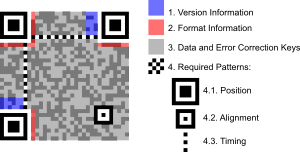
QR Code for the URL of the English Wikipedia Mobile main page. Note that the white border is part of the encoding.
Common in Japan, where it was created by Toyota subsidiary Denso-Wave in 1994, the QR code is one of the most popular types of two-dimensional barcodes. QR is the abbreviation for Quick Response, as the creator intended the code to allow its contents to be decoded at high speed.[1]
Source
Respecto al código QR (y por ende, los códigos de barras) para leerlos utilizar una webcam (de las más baratas) y el programa zbar en su variante linux con un pequeño script que me permite volcar directamente los datos recibidos por la cámara (ya sea EAN-13 o QR) en el formulario de entrada. Fácil y barato.
En lo referente a los productos, en aquellos que no tienen código de barras del fabricante y que con el código QR puedo personalizar (por ejemplo, el cliente, con una aplicación para teléfono le entrega la URL de la tienda online dónde puede realzar la comprar/reserva o ver más detalles del producto)




 LibreOffice
LibreOffice Firefox
Firefox
No comments:
Post a Comment